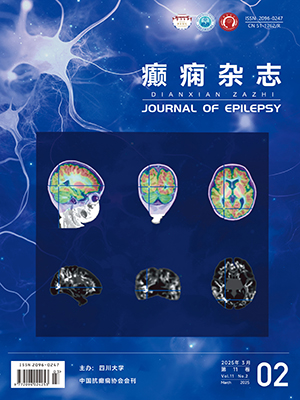| 1. |
Wang YJ, Li ZX, Gu HQ, et al. China stroke statistics: an update on the 2019 report from the national center for healthcare quality management in neurological diseases, china national clinical research center for neurological diseases, the chinese stroke association, national center for chronic and non-communicable disease control and prevention, chinese center for disease control and prevention and institute for global neuroscience and stroke collaborations. Stroke Vasc Neurol, 2022, 7(5): 415-450.
|
| 2. |
《中国脑卒中防治报告2021》编写组. 《中国脑卒中防治报告2021》概要. 中国脑血管病杂志, 2023, 20(11): 783-793.
|
| 3. |
卢葭, 刘献增. 脑卒中后痫性发作与癫痫临床诊治的研究进展. 山东医药, 2019, 59(13): 99-102.
|
| 4. |
Pitkanen A, Roivainen R, Lukasiuk K. Development of epilepsy after ischaemic stroke. Lancet Neurol, 2016, 15(2): 185-197.
|
| 5. |
Galovic M, Dohler N, Erdelyi-Canavese B, et al. Prediction of late seizures after ischaemic stroke with a novel prognostic model (the select score): a multivariable prediction model development and validation study. Lancet Neurol, 2018, 17(2): 143-152.
|
| 6. |
于跃. 基于机器学习的急性缺血性脑卒中后癫痫预测模型构建与评价. 青岛大学, 硕士学位论文, 2023: 1-54.
|
| 7. |
王芳, 王喜玲, 陈文丽, 等. 神经功能损伤与脑卒中后继发性癫痫的相关性分析. 中西医结合心脑血管病杂志, 2022, 20(11): 2084-2087.
|
| 8. |
Strzelczyk A, Haag A, Raupach H, et al. Prospective evaluation of a post-stroke epilepsy risk scale. J Neurol, 2010, 257(8): 1322-1326.
|
| 9. |
郭娜, 陈佳伟, 侯冰洁, 等. 脑卒中后癫痫危险因素及列线图预测模型构建. 四川医学, 2021, 42(05): 496-500.
|
| 10. |
Yamada S, Nakagawa I, Tamura K, et al. Investigation of poststroke epilepsy (inpose) study: a multicenter prospective study for prediction of poststroke epilepsy. J Neurol, 2020, 267(11): 3274-3281.
|
| 11. |
樊志霞. 缺血性脑卒中后早期癫痫发作和晚期癫痫发作的危险因素分析. 河北医科大学, 硕士学位论文, 2023: 1-34.
|
| 12. |
曾榕, 刁丽梅. 缺血性脑卒中后癫痫危险因素及预测模型研究. 医学研究杂志, 2024, 53(02): 173-177. .
|
| 13. |
慕鹏莺, 王梦碧, 刘晓荷, 等. 脑梗死后血清sil-2r, lp-pla2水平变化对继发癫痫的预测作用. 卒中与神经疾病, 2022, 29(4): 344-348. .
|
| 14. |
尼沙古丽·吐尔逊, 朱沂. 桥脑梗死的研究进展. 神经损伤与功能重建, 2014, 10(1): 59-60.
|
| 15. |
刘慧敏, 李明龙. 低钠血症诊疗研究进展. 中华老年多器官疾病杂志, 2018, 17(3): 233-236.
|
| 16. |
吴兴饶, 孔庆霞. 卒中后癫痫合并低钠血症一例. 中国卒中杂志, 2017, 12(4): 345-349.
|
| 17. |
郭佳, 吕邵敏, 刘瑞寒, 等. 高同型半胱氨酸血症与癫痫关系的研究进展. 癫痫与神经电生理学杂志. 2023, 32(4): 233-238.
|
| 18. |
刘辰庚, 高原, 王培昌. 5种脑脊液酶在癫痫和帕金森病中的检测应用. 国际检验医学杂志. 2018, 39(23): 2853-2856.
|
| 19. |
梁维, 潘剑罡, 廖志敏, 等. 不同类型癫痫患者血清尿酸和神经元特异性烯醇化酶水平的变化. 广东医科大学学报, 2023, 41(5): 556-558.
|
| 20. |
陈凡, 侯群, 蒋艳. 尿酸在癫痫患者中作用的研究进展. 浙江临床医学, 2023, 25(01): 151-153.
|
| 21. |
Dressler A, Chiara H, Benninger F, et al. Effects of the ketogenic diet on platelet counts and global coagulation tests in childhood epilepsy. Seizure, 2020, 80: 31-37.
|
| 22. |
孔丽. 丙戊酸钠对癫痫患者血小板计数及出血时间的影响. 现代中西医结合杂志, 2009, 18(20): 2420-2420.
|




